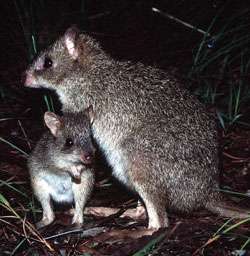Credit: Karl Vernes
(Phys.org)—A group of leading conservation scientists from The University of Queensland (UQ) and James Cook University (JCU) has exposed the private life of a small, endangered kangaroo.
In the first genetic paternity study of the Northern Bettong, researchers from the two universities have discovered that males generally prefer to mate with the 'girl next door', and may sometimes form pairs.
The research has been published online in The Australian Journal of Zoology.
Lead researcher, Dr Lisa Pope said the study found that statistically, males were more likely to mate with a female that was closer, based on day-time nest location.
The study looked at one population of Northern Bettong, found at Davies Creek in Far North Queensland.
Radio-tracking information combined with 'genetic fingerprints' allowed the researchers to describe the mating system of this endangered species.
"Because they stay in the same place so faithfully, mating with the female nesting closest might lead to long term pairs. Even after a fire across the study site, most animals were still nesting nearly exactly where they had been before the fire, hidden in rock piles or under burnt out logs," Dr Pope said.
"These animals eat underground fungi, or truffles. They live in eucalyptus forest and need fire to both stop the rainforest expanding and taking over their habitat, and to increase the numbers of truffles."
Information on mate choice preferences can inform conservation programs attempting to establish new populations of this species.
Dr Pope also believes that many people aren't aware of the diversity of kangaroo species in this country and the need for conservation programs for some species.
"While some kangaroo species are very common, many are rare and endangered. The Northern Bettong is one of the rarest mammals in Australia, which is why few people will have even heard of it," Dr Pope said.
Only four populations of the Northern Bettong remain and these are threatened by loss of habitat and increasing fox and pig numbers in north Queensland.
"They are an amazing kangaroo. Before I started working on them I had no idea that such small kangaroos existed. They are about the size of a rabbit and they have a prehensile tail that they use to pick up grass to help construct their day-time sleeping nest," Dr Pope said.
Journal information: Australian Journal of Zoology
Provided by University of Queensland





















